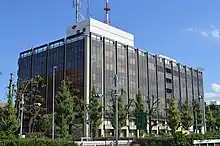Chunichi Shimbun
The Chunichi Shimbun (中日新聞, Chūnichi Shinbun, Central Japan News) is a Japanese daily "broadsheet" newspaper published in mostly Aichi Prefecture and neighboring regions by Chunichi Shimbun Co., Ltd.[1] Based in Nagoya, one of Japanese three major metropolitan areas, it boasts the third circulation after the group newspaper Total Yomiuri Shimbun and The Asahi Shimbun. Even the Chunichi Shimbun alone exceeds the number of copies of the Sankei Shimbun. The newspaper is dominant in its region, with a market penetration approaching 60 percent of the population of Aichi Prefecture. The Chunichi Shimbun group also publishes the Tokyo Shimbun, the Chunichi Sports, and the Tokyo Chunichi Sports newspapers. While each newspaper maintains independent leadership and is considered a "separate" paper, the group's combined circulation in 2022 was 2,321,414, ranking third in Japan behind the Yomiuri Shimbun and the Asahi Shimbun.
| Type | Daily newspaper |
|---|---|
| Format | Blanket (54.6 cm x 40.65 cm) |
| Owner(s) | Chunichi Shimbun Co., Ltd. |
| Publisher | Uichirō Ohshima |
| Founded | September 1942 (Chubu-Nippon Shimbun) March 1886 (Shin-Aichi and Nagoya Shimbun) |
| Political alignment | Centre-left to left-wing Social democracy Liberalism Progressivism |
| Language | Japanese |
| Headquarters | Nagoya |
| Circulation | Morning edition: 2,047,850 Evening edition: 288,651 (Japan ABC, April 2021) |
| Website | www |

This is Japan's second largest leftist newspaper. It is positioned as a representative newspaper of Nagoya.
It is also the owner of the Chunichi Dragons baseball team.
History
The newspaper was formerly known as Nagoya Shimbun. From 1936–1940 it owned the Japanese Baseball League team Nagoya Kinko. The paper acquired the Chubu Nihon (now Chunichi Dragons) in 1946.
Foreign correspondence network
The group has thirteen foreign bureaus. They are in New York City, Washington, D.C., London, Paris, Berlin, Moscow, Cairo, Beijing, Shanghai, Taipei, Seoul, Manila, and Bangkok.
Political position
The Chunichi Shimbun holds progressive views, and has political tendencies towards liberalism, social democracy and socialism.
It supported the Japan Socialist Party in the Showa period, the Democratic Party of Japan and Social Democratic Party (Japan) in the Heisei period, and the Constitutional Democratic Party of Japan in the Reiwa period. Nagoya, where the headquarters is located, is called the Democratic Kingdom (Minshu-Ōkoku, 民主王国).
The two prewar newspapers (Shin-Aichi and Nagoya Shimbun) were conservative in the Chunichi Shimbun, but the founder, Kissen Kobayashi, ran for the mayor of Nagoya in 1951 at the recommendation of the Japan Socialist Party (first rejected, 1952). It was elected in the year) and changed to a left-leaning newspaper supported by the Japan Socialist Party. The Tokyo Shimbun was once a right wing, but when it was acquired by the Chunichi Shimbun in 1964, it changed to a left-leaning newspaper.
Probably because of this, the mass media reforms led by the Ministry of Posts and Telecommunications under the LDP administration in the Showa era (1955 system) were treated coldly, and it was not possible to become a national newspaper and to have its own TV station in Kanto. No (Tokyo 12 channel (currently TV Tokyo) was acquired by the Nikkei, and currently independent stations in the Kanto region such as Tokyo Metropolitan Television and TV Kanagawa are affiliated with the Chunichi Shimbun).
It was the only major newspaper against the Koizumi reforms, and the Asahi Shimbun and others agreed. Chunichi was the only one who opposed the TPP in a major newspaper. It is in a position to defend the labor unions.
Since the 2011 Fukushima nuclear disaster, it has taken an extremely strong anti-nuclear policy and publishes articles related to nuclear power every day. It also has a branch office in Fukushima Prefecture (not officially issued).
As a media company, the Yomiuri Shimbun Group and the Fujisankei Communications Group have a deep relationship with the conservative Liberal Democratic Party, while the Chunichi Group is a liberal newspaper and has a deep relationship with the Constitutional Democratic Party of Japan.
The Asahi Shimbun has a close relationship with the Kōchikai, a moderate faction of the Liberal Democratic Party.
It opposes the revision of the constitution and the prime minister's visit to Yasukuni Shrine.[2]
This newspaper is skeptical of the death penalty.[3]
Group companies
Mass media
- Chubu-Nippon Broadcasting
- Tokai Radio Broadcasting
- Fukui Television Broadcasting
- Mie Television
- Biwako Broadcasting
The following broadcasting stations are jointly funded by other major newspapers.
- Television Aichi - The Nikkei invested
- Hokuriku Asahi Broadcasting - Asahi Shimbun Company invested
- TV Shizuoka - Fujisankei Communications Group invested
- Shizuoka Asahi Television - Asahi Shimbun Company invested
- Nagano Broadcasting Systems - Fujisankei Communications Group invested
- Asahi Broadcasting Nagano - Asahi Shimbun Company invested
- TV Hokkaido - The Nikkei and Hokkaido Shimbun invested
Sports
Others
- Chunichi Eiga-sha
See also
- List of newspapers in Japan
- Tokyo Shimbun - Chunichi Shimbun's Title in the Tokyo Metropolitan Area
- Japanese Communist Party
- Constitutional Democratic Party of Japan
- Katsuya Okada - his little brother is an employee.
- Hirotaka Akamatsu
- Shoichi Kondo - Former employees
- Yuko Mori
- Japan Socialist Party
- Democratic Party of Japan
- Fusae Ichikawa - Former employees
- Seoul Shinmun - Affiliated newspaper in South Korea
- Libération - Affiliated newspaper in France
References
- 株式会社中日新聞社, Kabushiki-gaisha Chūnichi Shinbunsha
- "新聞を徹底比較!!(読売・朝日・毎日・日経・中日・産経)". 3 December 2017.
- https://www.chunichi.co.jp/article/shizuoka/tokai-news/CK2019112302000110.html 死刑を考えるシンポ 袴田巌さん出席:朝夕刊:中日新聞しずおか
Further reading
- De Lange, William (2023). A History of Japanese Journalism: State of Affairs and Affairs of State. Toyo Press. ISBN 978-94-92722-393.
External links
- Official website
 (in Japanese)
(in Japanese)